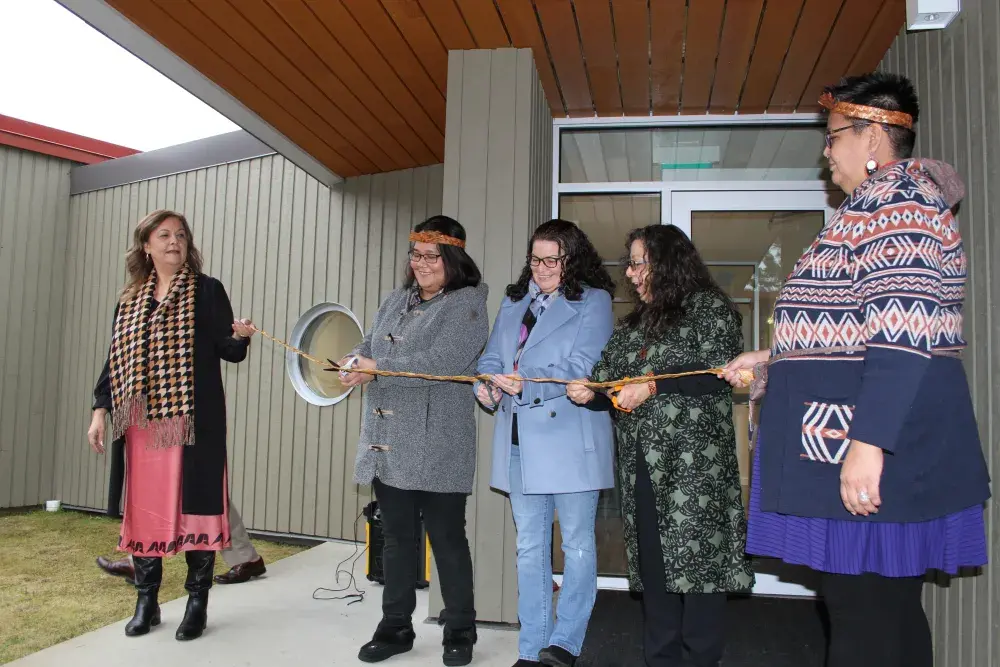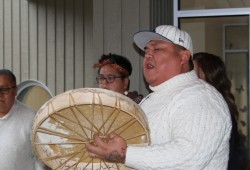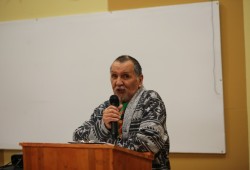The cumulative “snowball” effect from multiple generations of unresolved trauma is a factor behind the opioid crisis’s toll on First Nations, says the head of a family treatment centre that delves into the roots of addictions issues.
“It’s like a snowball rolling downhill, if you understand the whole disconnect that happened with residential school, the lack of attachment that kept occurring each generation after each generation,” said Lisa Robinson, executive director of the Kackaamin Family Development Centre. “It’s everything, attachment, your love source. How are you going to develop as a human being and learn how to cope? Life is hard even if you had two parents, all the love in the world, you’ll still struggle…But what if that wasn’t there at all?”
Working under the philosophy that young ones are at the centre of the family circle, Kackaamin is celebrating the expansion of its daycare facility, which supervises children while families are undergoing treatment, staying at the facility. Running Indigenous-focused programs that usually last multiple weeks for addictions, trauma and grief issues, the Kackaamin facility outside of Port Alberni was previously able to just host up to eight pre-school children. Now with a provincially funded expansion worth over $3 million up to a dozen youngsters can stay at the daycare, enabling Kackaamin to expand its services at a critical time for many struggling families.
“We are going through a really dark period in our history with the losses,” said Robinson at an event announcing the daycare expansion on Dec. 18. “You need to get people in decent space if they want to heal. There’s no way in hell you can get them to do anything vulnerable if they’re living on the street.”
So far this winter the hazards appear to be intensifying for those who are exposed to street drugs. On Dec.13 the BC Coroners Service issued a “public safety warning to anyone using substances purchased from the illicit market,” after the death toll has risen to an average of seven a day across the province in recent weeks. This year is expected to see the most fatalities from the crisis, with recent coroner data showing over 200 deaths in November.
Originally introduced as a medical-grade painkiller, fentanyl has found its place on the illicit market. Since the opioid crisis was declared a public health emergency in 2016 fentanyl has dominated fatal cases, and has so far been found in 83 per cent of deaths by illicit drug use in 2023. Now even cases of counterfeit hydromorphone, which is being used as a prescribed alternative to illicit drugs, have been reported from Interior Health.
In British Columbia, Indigenous people have been affected by illicit drug fatalities at a rate that is five times that of the rest of the population, according to data reported by the First Nations Health Authority last year.
Robinson notes that a deep-seated sense of disconnection is behind addiction, regardless of race.
“There’s not just native people dying, there’s all colours dying- but it’s probably the same,” she said. “What happened to them? Were they cared for when they were little? Did they feel loved?”
Tseshaht member Richard Watts is on Kackaamin’s board of directors. He says the on-site daycare is symbolic of the centre’s approach to treating the whole family.
“I grew up in a community, a family and a home where my dad was out working full time, my mom was a mother raising the kids,” said Watts during the Dec 18 event. “At the same time we had this serious problem with alcohol in our community and our family. It was sort of swept under the rug.”
Alcoholism persisted into Watts’ adulthood, but he eventually had to confront the issue.
“Several years ago I decided that was not the way to be and chose to leave it behind,” he said. “But along the way I learned of all the things I had to deal with in my life, all the dysfunction that went on. It’s been a struggle but it’s worthwhile.”
At Kackaamin, a critical part of the healing process is enabling families to live in a comfortable, drug and alcohol-free space over their treatment. A safe environment is needed to stop the patterns of trauma that can start in childhood.
“Mostly when families come here, we say, ‘Get that hurt out of the way so you can remember who you are’,” Robinson explained. “It’s quite amazing what you can see happen when people clear that stuff out. It’s just a natural place people get to where you’re comfortable, you can be yourself.”
In September the province announced another expansion for Kackaamin’s services, with 10 publicly funded beds for addictions recovery. With Nuu-chah-nulth-aht given the priority, the centre had already started offering this support to individuals during the COVID-19 pandemic, when the need for supportive treatment to individuals became increasingly apparent.
“We’re targeting people who might have nowhere else to go,” said Robinson of the recovery program for individuals. “We’re making sure we’re helping with the crisis at hand.”
But detox is required before anyone can access this program, a medical component to addictions treatment that Robinson believes is severely lacking.
The absence of a detox centre in the Alberni Valley or on Vancouver Island’s west coast has been a point of frustration for many in recent years. In April 2022 the Nuu-chah-nulth Tribal Council called on governments for an around-the-clock facility in Nuu-chah-nulth territory that immediately gets people off street drugs through detox treatment, but this has yet to be prioritized by health authorities or the province.
“That’s a huge need…it’s lacking, that medical piece,” said Robinson, reflecting that addictions can be a temporary survival tactic for people who struggle with old trauma. “Everyday stresses become big triggers for people, they can’t cope. It’s a temporary fix. When you’re using substances it will numb that pain for that moment, because maybe that’s all that’s keeping them alive.”




